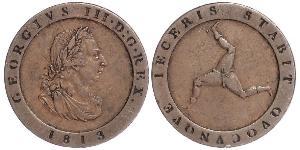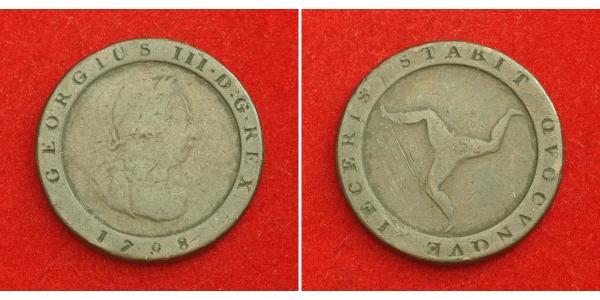(Vendida por $24.0)
1798, Isle of Man (British Dependency), George III. Copper ½ Penny Coin. F+
Mint Year: 1798
Reference: KM-10.
Denomination: ½ Penny
Condition: Scratches in reverse, otherwise F+
Material: Copper
Weight: 10.32gm
Diameter: 27mm
Obverse: Wreathed bust of George III of Great Britain.
Legend: GEORGIVS III . D . G . REX 1798
Reverse: Triskeles. Motto ("Whithersoever you throw it, it will stand") around.
In 1765, Charlotte Murray, Duchess of Atholl, 8th Baroness Strange, sold the suzerainty of the island to the British government for £70,000 and an annuity of £2,000 (£5,235,000 and £150,000 respectively in modern terms). By the passage of the Isle of Man Purchase Act 1765 the title of Lord of Mann was revested into the British Crown. It has therefore since been used on the Isle of Man to refer to the reigning Monarch of the United Kingdom.
The Isle of Man, otherwise known simply as Mann, is a self-governing British Crown Dependency, located in the Irish Sea between the islands of Great Britain and Ireland. The head of state is Queen Elizabeth II, who holds the title of Lord of Mann. The Lord of Mann is represented by a Lieutenant Governor, but its foreign relations and defence are the responsibility of the British Government.
The island has been inhabited since before 6500 BC. As one of the six Celtic nations, Gaelic cultural influence began in the 5th century AD, and the Manx language, a branch of the Gaelic languages, gradually emerged. In 627, Edwin of Northumbria conquered the Isle of Man along with most of Mercia. In the 9th century, the Norse began to settle there. Norse people from Scotland then established the Kingdom of the Isles. The King's title would then carry the suffix, "and the Isles". Magnus III, the King of Norway, was also known as "King of Mann and the Isles" as part of the Hebrides civilization between 1099 and 1103. A Norse-Gaelic culture arose and the island came under Norse control. In 1266, the island became part of Scotland, as formalised by the Treaty of Perth. After a period of alternating rule by the kings of Scotland and England, the island came under the feudal lordship of the English Crown in 1399. The lordship revested into the British Crown in 1765, but the island never became part of the Kingdom of Great Britain or its successor the United Kingdom, retaining its status as an internally self-governing Crown dependency.

1/2 Penny Isla de Man Cobre Jorge III (1 ...
grupo tiene 6 monedas / 6 precios
Add coin to this group

1 Penny Reino de Gran Bretaña (1707-1801 ...
grupo tiene 19 monedas / 15 precios
Add coin to this group

2 Penny Reino de Gran Bretaña (1707-1801 ...
grupo tiene 27 monedas / 23 precios
Add coin to this group
1/2 Cent Reino de los Países Bajos (1815 - ) Cobre Guillermo ...
grupo tiene 10 monedas / 10 precios
⇑













-300-150-ZwusHgTycaAAAAGPadNVj7Mq.jpg)







